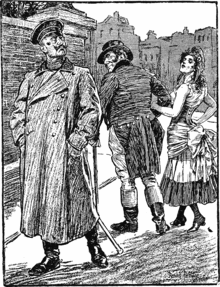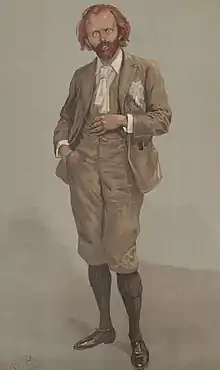Bernard Partridge
Sir John Bernard Partridge (11 October 1861 – 9 August 1945)[1] was an English illustrator. Born in London, he was the son of Professor Richard Partridge, F.R.S., president of the Royal College of Surgeons,[2] and nephew of John Partridge, portrait-painter extraordinary to Queen Victoria.[2] For some years he was well known as an actor under the name of Bernard Gould.[3][4]


Life and work
Partridge was educated at Stonyhurst College where one of his fellow pupils was Arthur Conan Doyle.[5] After matriculating at the University of London,[6] he worked for six months in the offices of architect H. Handsom, and then joined the firm of Lavers, Barraud and Westlake, ecclesiastical designers, where he spent two years producing alter-pieces, stained-glass etc.[5] He then studied decorative painting under Philip Westlake, 1880–1884. He began illustration for the press and practised watercolour painting, but his chief success was derived from book illustration.
Partridge was very interested in the theatre and acted under the stage name Bernard Gould.[3] He appeared in the first production of George Bernard Shaw's Arms and the Man. Many of his early drawings were of stage subjects or personalities, and some of his finest caricatures in later life were drawn from the world of the stage.[7] Partridge was a frequent exhibitor,[note 1] exhibiting nearly 200 works in total.
In 1891 Partridge joined the staff of Punch [9] and, in 1910, became its chief cartoonist, replacing Edward Linley Sambourne. During his time at Punch, Partridge published several cartoons supporting the Suffragist movement. He was elected a member of the Royal Institute of Painters in Water Colours and of The Pastel Society. In 1915 he designed posters to encourage recruitment to the British Army, some of which are now held at the State Library of Victoria, Melbourne, Australia, including Take up the Sword of Justice which featured the sinking of the RMS Lusitania (H33861/33). Partridge was one of the leading illustrators selected by Percy Bradshaw for inclusion in his The Art of the Illustrator (1917-1918) which presented a separate portfolio for each of twenty illustrators.[note 2]
In 1925 Partridge was knighted on the advice of Prime Minister Stanley Baldwin and gave his support to the government during the General Strike.
Notes
- Partridge exhibited as follows: 112 works at the Fine Art Society, three works at the Glasgow Institute of the Fine Arts, 12 works at the Walker Art Gallery, Liverpool, 44 works at the Leicester Galleries, two works at the New English Art Club, 18 works at the Royal Academy, and three works at the Royal Institute of Painters in Water Colours.[8]
- The portfolio contained: a brief biography of Partridge, an illustration of Partridge at work in his studio, an explanation of Partridge's method of working. This was accompanied by a plate showing an illustration typical of his work and five other plates showing the work at five earlier stages of its production, from the first rough to the just before the finished drawing or colour sketch.[10] Partridge's pen and ink drawing shows what appears to be a German cavalry man with a ragged, blindfolded woman riding pillion on a mountain road. It was reproduced by permission of Punch and was probably a political reference to the First World War. The extraneous sketches in the preparatory work suggest that this was from his sketch-book, rather than being specially prepared.[11]
References
- "Obituary: Sir Bernard Partridge". The Times. p.6 col.5. 11 August 1945.CS1 maint: location (link)
- A. & C. Black Ltd. (1967). Who Was Who: Volume IV 1941-1950: A Companion to Who's Who Containing the Biographies of Those Who Died During the Period 1941-1950. Vol 4 1941-1950 (4th ed.). London: Adam and Charles Black. p. 889. Retrieved 12 August 2020 – via The Internet Archive.
- Room, Adrian (2004). Dictionary of Pseudonyms (4th ed.). Jefferson: McFarland & Company, Inc. p. 204. ISBN 0-7864-1658-0. Retrieved 12 August 2020 – via The Internet Archive.
- "Bernard Partridge". British Cartoon Archive. Retrieved 14 December 2012.
- Bryant, Mark (2018). "Partridge, Sir John Bernard". The Dictionary of 20th-century British Cartoonists and Caricaturists. London: Routledge. p. 169. ISBN 978-1-315-20279-2.
- "Bernard Partridge". Spartacus Educational. Archived from the original on 3 December 2012. Retrieved 14 December 2012.
- Houfe, Simon (1981). Dictionary of British Book Illustrators and Caricaturists, 1800-1914 (Rev. ed.). Woodbridge: Antique Collectors' Club. p. 409. Retrieved 22 August 2020 – via The Internet Archive.
- Johnson, J.; Greutzner, A. (8 June 1905). The Dictionary of British Artists 1880-1940. Woodbridge: Antique Collectors' Club. p. 391.
- "PARTRIDGE, Bernard". Who's Who. Vol. 59. 1907. p. 1362.
- "The Connisseur Bookself". The Connoisseur: An Illustrated Magazine for Collectors. 51 (204): 223. 1 August 1918. Retrieved 12 August 2020 – via The Internet Archive.
- "Bernard Partridge: Bernard Partridge and His Work: The Art of the Illustrator (Limited Edition Prints)". Illustration Art Gallery with The Book Palace. Retrieved 22 August 2020.
 This article incorporates text from a publication now in the public domain: Chisholm, Hugh, ed. (1911). "Partridge, John Bernard". Encyclopædia Britannica (11th ed.). Cambridge University Press.
This article incorporates text from a publication now in the public domain: Chisholm, Hugh, ed. (1911). "Partridge, John Bernard". Encyclopædia Britannica (11th ed.). Cambridge University Press.
External links
| Wikimedia Commons has media related to John Bernard Partridge. |
- Works by or about Bernard Partridge at Internet Archive
- Portraits of Bernard Partridge at the National Portrait Gallery (London).
- http://slv.vic.gov.au State Library of Victoria, Melbourne, Australia.
- The Bernard Partridge Drawings Collection is held by the Victoria and Albert Museum Theatre and Performance Department.
- Partridge's Illustrations from Punch in HeidICON
- Partridge's Illustrations at the British Library Flickr account
- Works by Bernard Partridge at Project Gutenberg
- Bernard Partridge at Library of Congress Authorities, with 14 catalogue records